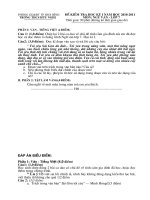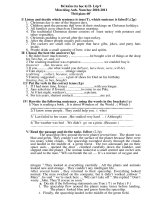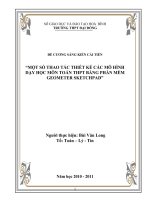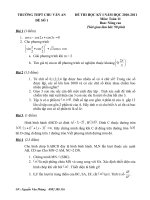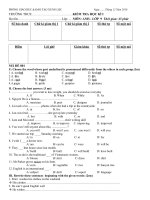Bài giảng dề anh van
Bạn đang xem bản rút gọn của tài liệu. Xem và tải ngay bản đầy đủ của tài liệu tại đây (133.25 KB, 4 trang )
Lesson plans of English 10
05
th
January, 2008
Period 1
Unit 9: UNDERSEA WORLD
A. READING (Page 94 – 96)
I. Objectives:
A. Educational aim: By the end of this lesson, students will understand more about marine life and have
some proper attitudes towards protecting them.
B. Knowledge:
a) General knowledge: By the end of this lesson, students can understand the reading and do the
tasks below.
b) Language:
i. Vocabulary: Pacific, Atlantic, Indian, Antarctic, and Arctic Oceans, marine, gulf, bay,
starfish, biodiversity, at stake, to maintain
ii. Grammar: simple present tense
C. Skill : Reading
D. Teaching aid: Textbook, board, and chalks
E. Techniques : Pair work, group work, separate work.
II. Procedure:
A. Classroom arrangement and taking attendance:
B. Today’s lesson:
Unit 9: UNDERSEA WORLD
A. READING (Page 94 – 96)
Teacher’s and students’
activities
Content
_ T divides class into 2 groups,
asks Ss to list out some marine
life that they know.
_ Ss discuss and give as many
names of marine life as they know
and write the marine life on the
board.
After 3 minutes, T checks the
answers. Which group has more
correct names will be the winner.
_ T asks Sc to open the book and
do the questions
_ Ss answer. T invite them to
write the answers on the board.
_ T checks the answers.
I. Warm up: Game: Marine life
_ Tell me some marine life that you know?
Examples: Dolphin, Whale, Starfish, seadog, seal, turtle, shark,
mackerel, ray, skate…
II. Before you listen:
Suggested answers:
The oceans
:
Pacific ocean: Biển Thái Binh Dương
Atlantic ocean: Biển Đại Tây Dương
Indian ocean: Biển Ấn Độ Dương
Antarctic ocean: Biển Nam Cực
Arctic ocean: Biển Bắc Băng Dương
The sea animals:
Seal, Jellyfish, Turtle, Shark
- 3
Lesson plans of English 10
_ T plays the tape 1 to 2 times,
then asks students to do task 1.
_ T asks Ss to find where the
words provided in the box are in
the text, find their classification
(N, adj, adv, v, ..)
Ss do task 1
in groups of 3 to 4 students.
_ T invites some Ss to do the task
one by one
Ss answer,
translate into Vietnamese and
write the answers on the board.
_ T checks the answers.
_ T asks Ss to do the task 2 in
groups of 3 or 4, answer the
questions
Ss discuss and
present their answers.
_ T invites some Ss to answer,
corrects, and have them write the
answers on the board.
_ Ss write the answers on the
board
T check their writings
and asks others to take notes.
_ T asks Ss to work in groups,
read the words provided in the
box first, explain their meanings
Ss listens and take notes, then
do the task.
_ T invites some Ss to answer and
write the answers on the board.
_ T checks and gives comments.
III. While you read:
Task 1:
Suggested answers:
1. tiny
2. reveal
3. gulf
4. biodiversity
5. samples
Task 2:
Suggested answers:
1. 75%
2. By using more sophisticated tools
3. To investigate the seabed and bring samples of the marine life
back to the surface for the further study.
4. Provide a wide range of information, including water
temperature, depth and the undersea populations.
5. Group 1: live on or depend on the bottom like the starfish.
Group 2: swimming animals such as fishes and sharks that
more independently of water currents.
Group 3: tiny organisms that are carried along by the currents
like the jellyfish.
6. If the sea biodiversity was not maintained, the marine life would
be at stake.
IV. After you read:
Suggested answers:
1. three – quarters
2. mysterious
3. modern
4. discoveries
5. plants and animals
6. huge
7. biodiversity
8. closely connected
C. Consolidation:
T asks Ss to read the summary and translate it into Vietnamese.
D. Homework:
Ss read the passage fluently, translate it into Vietnamese, and learn by heart all new words.
D. Preparation for the next lesson:
Unit 9: (cont)
B. Speaking (page 97)
6
Lesson plans of English 10
C. Teacher’s comment on students’ attendance and participation.
06
th
January, 2008
Period 2
Unit 9: UNDERSEA WORLD
B. SPEAKING (Page 97)
I. Objectives:
A. Educational aim: By the end of this lesson, students will practice talking about the ocean
and how to protect it from polluted
B. Language:
Vocabulary: Pacific, Atlantic, Indian, Antarctic, and Arctic Oceans, marine, gulf, bay,
starfish, biodiversity, at stake, to maintain
Grammar: simple present tense
C. Skill : Speaking
D. Teaching aid: Textbook, board, and chalks
E. Techniques : Pair work, group work, separate work.
II. Procedure:
A. Classroom arrangement and taking attendance:
B. Review of the previous lesson:
T asks 3 students to read the passage and translate into Vietnamese, then answer the following
questions:
1. How many oceans are there in the world?
2. What do we use submarine for?
3. The marine life is divided into 3 ,main groups. What are they?
C. Today’s lesson:
Unit 9: UNDERSEA WORLD
B. SPEAKING (Page 94 – 96)
Teacher’s and students’
activities
Content
_ T asks Ss the question. Ss try to
express their ideas in English.
_ T checks and lead in today’s
lesson
_ T helps Ss to discuss in pairs,
using the following suggestions
_ Ss do the task in pairs. After
that, T presents the models beside
and asks Ss to practice.
_ T invites some pairs to present
their discussions.
_ Ss present their dialogue
T
I. Warm up:
Questions: _ What would you do if your living surrounding has so
much rubbish?
II. Before you speak:
Task 1: (Pair work)
Useful language:
Ways to ask for opinions:
_ What do you think of (using herbicides)?
_ How do you feel about (being a smart shopper)?
_ What’s your opinion of (fishing for species)?
Ways to give your opinions:
_ Well, I think
- 5
Lesson plans of English 10
listens, give comments and
corrects their mistakes if
necessary.
_ T asks Ss to read to task
carefully, then asks them to work
in groups, discuss the
consequences that might occur
and offer some possible solutions.
_ T invites some groups to go to
the board and report what they
have discussed.
_ Some Ss report, others asks
some questions for their
presentation
_ T gives comments and mark for
the groups.
_ In my opinion
_ As far as I’m concerned
_ We should
_ We shouldn’t
Suggested answers:
A: What do you think of placing rubbish and plastic bags in proper
dustbins?
B: I think it is essentially to protect the environment from being
polluted.
III. While you speak:
Task 2:
(
group work
)
Suggested answers:
Threats Consequences Solutions
1. Beaches filled
with plastic bags
_ polluted water _ place plastic bags
in proper dustbins
2. Whales hunts
for food
_ extinct/
disappear
_ (Governments)
don’t let people sell
whale products
3. Explosives
used to catch fish
_ A lot of fish
died
_ Be banned
4. Oil spilled
from tankers
_ Polluted water Punish captain
5. Pesticides
blown off the
fields into the sea
_ Polluted water _ Clean up the
water before
running into the sea
IV. After you speak:
Task 3:
Report to the class what you have just discussed.
D. Consolidation:
Question: What should you do to protect the environment?
E. Homework:
Practice speaking with the suggestions above and learn by heart all new words and structures
F. Preparation for the next lesson:
Unit 9: (cont)
C. Listening (Page 98 – 99)
G. Teacher’s comment on students’ attendance and participation.
6


